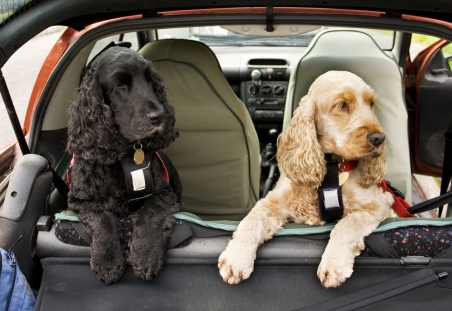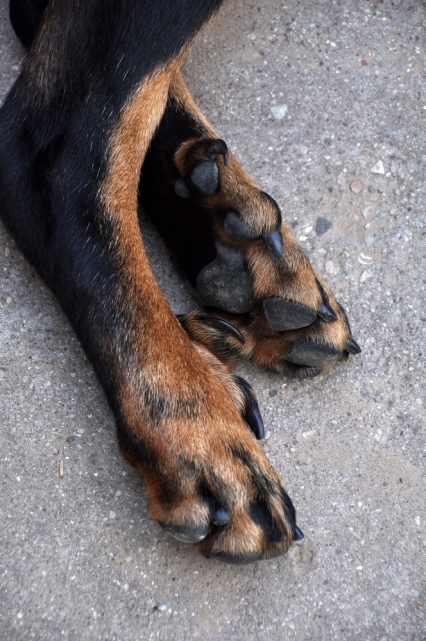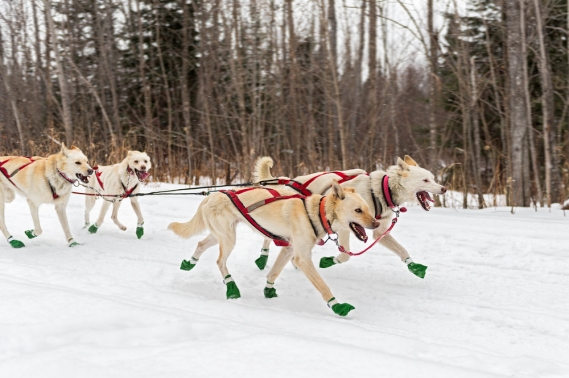Risks & Rewards of Spaying: AKA Ovariohysterectomy
by Amber Kingsley

The term “hysterectomy” can strike a sense of permanent fear into some people’s minds, but it’s actually a simple, relatively inexpensive and important procedure performed on many of our pets everyday. As the late-great Bob Barker once reminded us at the end of his daily game show, “Help control the pet population, have your pet spayed or neutered.”
So important was this message, Bob’s replacement on the “Price Is Right” game show, today’s host Drew Carey, continues to convey this valuable reminder. In the meantime, the ASPCA delivers some scary statistics when it comes to animal overpopulation in America. While some of these numbers are difficult to predict with exact accuracy, the numbers are still overwhelming:
- Only 10% of strays in turned into shelters are “fixed”
- Luckily, 83% of dogs and 91% of cats that are “owned” are spayed (or neutered)
- A dog produces an average of one litter a year with four to six puppies
- Cats can deliver two or more litters in a year, averaging the same number of offspring
Dollars and Sense
The price of spaying a female pet is much less than the costs associated with caring for a puppy or kitten for their first year of life. This simple investment of spaying can not only help control the pet population, but also saves owners a great deal in veterinarian expenses, extends their pet’s lifespan, and greatly reduces the risks of many forms of cancer, including mammary and ovarian forms of this deadly disease.
Timely Recommendations
Some pet owners ponder, “When should I have my animal spayed?” Experts recommend an animal should go through this procedure around the age of 6 to 8 months or before they have their first menstrual cycle. Some say that animals can undergo this procedure as early as 8 or 12 weeks of age, but this greatly increases their risk of developing incontinence issues and urinary tract infections. In this instance, later is better than sooner, but don’t wait too long, before they’re a year old or go through what humans would call “puberty.”
Risks Versus Rewards
While we’ve been concentrating on the many rewards of spaying your female pets, but at the same time there are risks involved. As with any surgical procedure, being put under general anesthesia is not without danger. There are some rare (actually extremely rare) instances of death or illnesses associated with the use of anesthesia with pets. Not to sound repetitive, but putting them under the knife when they’re too young puts them at a greater risk of developing other problems later in life.
Weighing Your Options
Unless you’re prepared to properly care for a litter, find them loving forever homes and take responsibility for the possibility of regular offsprings, please take Bob and Drew’s advice … Please spay (or neuter) your pet to avoid all these problems. The risks are minimal compared to the rewards that are too great to ignore.
While puppies and kittens are cute when they come along, just like human children, they grow into an important and costly member of our family that comes with a lifelong commitment. You might not have to send a four-legged friend to college, but you’re still responsible for their health, welfare and upbringing as a part of your family.
3 Important, Unusual and Often Overlooked Summer Threats For Pets
By Amber Kingsley

In a previous post, we discussed common dangers for our beloved animals when temperatures begin to rise, but there’s some other hidden threats when it comes to the welfare of our pets during these warmer summer months.
While we can watch for signs and symptoms of dehydration and them becoming overheated as we discussed previously, but we can also be on the lookout for other potential perils for our pets. Some seem a little less obvious than others, so check out these three slightly unusual situations that can pose a threat for our animals:
#1 - On The Surface
We often let our pets out on the patio briefly or take them for a short walk during these hotter months being mindful of the time they spend outside. While we may be aware of the exterior air temperature, the mercury also rises more rapidly on the surfaces where they’re walking.
For example, when the thermometer reads 35 (95℉), the ground is a lot warmer. Studies have shown:
● Concrete sidewalks rise to 52℃ (125℉)
● Red bricks climb to 57℃ (135℉), and
● Black asphalt reaches 60℃ (140℉)
At the very least, this can be painful on their sensitive paws at the concrete level, but the temperature of asphalt can cause serious burns and scarring on their feet. If you won’t be walking barefoot with them outdoors, at least test the temperature of these surfaces before they must stroll across them.
#2 - Fireworks
The noise emanating from fireworks causes many animals grief, stress and anxiety so we recommend a natural calming agent, but the smell, taste and ingestion of these products are very toxic. Think of curious cats sniffing around some leftover fireworks or dogs who will put practically anything into their mouths, and you can easily see where this is going.
Along with having a “safe and sane” fireworks celebration, be sure the scraps leftover from this holiday are put into a bucket of water immediately. Drain the liquid safely and dispose of them in a tightly covered trash receptacle.
#3 - Backyard Barbeques
Nothing screams summer like a family-friendly, outdoor cooking event, but during this fun-filled day, can put our pets into some unexpected perils. Think of it this way, how many times have you seen a dog snag something from the hands of an unexpected child? While it’s certainly cute, it can be dangerous, what if it was a piece of chicken, full of bones that can shatter and cause our pets and cause them serious injuries.
Think of other threats that are strewn around our backyard that cause problems for our pets:
● Fruits & Vegetables: The summer brings out the finest in fresh fruits and veggies, while the majority of them are healthy for animals, others can be dangerous. For example, watermelon is a great treat for animals, but their seeds can cause intestinal problems. Grapes and raisins, commonly found in fruit salads are also toxic for pets.
● A Banquet of Leftovers: Unmonitored trash receptacles and plates full of leftovers left lying around are both an open invitation for overeating when it comes to our dogs and cats. These leave them wide open for allergies, possible gastric distress diarrhea and a host of other problems. Be sure that refuse containers have tightly closed lids and dishes are regularly cleared from tables and other dining areas.
● Dessert Dilemmas: While we all know that chocolate can be dangerous or even deadly for dogs, other end-of-the-meal treats can also pose threats. Many people don’t realize that an ingredient found in sugar-free gum and some desserts, xylitol is extremely toxic for pets. Grapes and raisins, popular summertime treats, are also toxic for pets.
Consider leaving your pet indoors or monitoring them very closely when they’re outside to prevent these dangerous dilemmas from occurring. With a little extra attention, we can ensure that we all have fun in the sun this summer.
Positive Reinforcement Training Tips
They don’t call them “man’s best friend” for nothing! Domestic dogs have for thousands of years lived with humans in various capacities, from aiding in hunting to protecting livestock. In order to perform these functions, dogs learned to communicate with people and perform as their owners wished.
Dogs are highly sensitive and responsive animals. They can tell when their owners are happy, sad, or nervous, and they may express these emotions themselves.
Because dogs do have feelings, and intelligence that may be compared to that of a toddler (some breeds are as smart as a human seven-year-old!), it’s important that you refrain from treating your pet negatively. Continually shouting at a small child may scare him into submission, but it probably won’t make for a happy or healthy young person in the long run, even if he does obey.
Your dog does not understand that you’re angry he got into the garbage bin; for one, dogs get into things because they’re dogs, and for two, his brain just isn’t going to connect your harsh tones and loud movements with all the fun he had with leftovers this afternoon. Just as with small children, dogs need to be coerced into behaving well with smiles and cheer.
Your pet will understand when you’re unhappy with him, but he won’t understand why so well as the fact that you just are. That’s why it’s important to work on refining your dog’s behavior in a different way, with positivity.
Positive reinforcement is one of the best methods of training your dog. It’s easier for your dog to understand what he did right, rather than grasping the concept of some arbitrary human rule he didn’t follow (such as resisting sticking his muzzle into the appealing-smelling trash bin). When you’re happy, your dog is happy as well.
As such, two of the best ways to train your dog are with enthusiasm and with puppy treats. Both of these need to be awarded to your pet immediately after he performs the desirable action, so that he understands and repeats it again.
Because dogs understand human emotions so well, it’s key to praise him when he does something correctly, even if it’s by accident. Use upbeat vocal tones, and repeated phrases like “Good dog!” Respond in this way when your dog completes commands, and pair it with petting and physical affection when you’re really proud.
Treats are a great idea for training. Your pet gets a treat for sitting instead of jumping on visitor, for not barking when the doorbell rings, when he fetches an item, and so on. As long as they don’t trigger a food allergy, treats are a safe and effective way for modifying behavior and completing training. Be patient at first, since your dog probably won’t understand right away.
It doesn’t take much to make dogs happy–pets and treats, please! Check out the infographic below for more on how to get your pet to please you with positive reinforcement.

5 Fun and Safe Travel Tips For Taking Rover on the Road
Written by: Amber Kingsley
When we think about hitting the road with our four-legged best friend, we often imagine the stereotypical dog with his head sticking out the window, his tongue and ears flapping in the wind. But this is actually very dangerous, aside from the possibility of being struck by a flying object, this also puts your animal at risk for health hazardous like an upper respiratory infection.
Driving is not without risk, but it can also be very rewarding, for both you and your pet. Keep in mind these tips for when you hit the open road with your animal:

#1 – Feel the Heat
While we all know not to leave a dog alone in a hot car, not even for one minute, sometimes we forget about other sources of heat, like sidewalks and pavement. On a typical summer’s day, when the outside temperature reaches 95℉, concrete sidewalks can heat up to 125℉ and black asphalt roadways can reach a blistering 140℉. More than uncomfortable, at these temperatures your animal is at risk for a serious burn. Take a moment to feel the surface where your dog will be walking in the summertime before you take them out for a walk.
#2 – Recreation for Them
Just like searching for pet-friendly lodging, look for recreations spots to take your dog to unwind while you’re out on the road. Other than rest stops, search for other places your pet might enjoy like dog-friendly beaches, parks, even some restaurants have outdoor dining areas that allow animals. Google these destinations that are along your route and just like any other member of your family and traveling companions, your dog will enjoy some of their favorite places.
#3 – Beach Blanket Bingo
When you do stop for some time at the coast, be sure to bring a blanket and source of shade for your dog to enjoy. Along with plenty of cool, fresh drinking water, your dog needs a place of relief from the hot sand and sun. Don’t forget those dog toys.

for a great day of fun and play at the beach with your buddy
#4 – Click It or Ticket
Just like our two-legged passengers, some states have laws requiring animals be restrained while traveling in vehicles. Some places forbid drivers from having a dog riding in their lap while behind the wheel and others can issue a citation for distracted driving involving a dog inside your car. In any event, be mindful of laws that can vary from location to location.
#5 – Events & Exercise
There’s a relatively new exercise-related dog event that’s been picking up steam lately and traveling around the country – dock diving. In case you’re unfamiliar with this growing trend, a number of different clubs and organizations take their mobile pools and docks out on the road and challenge area dogs and their owners to this competition. Usually chasing a toy and aiming for a target, these four-legged athletes are judged for distance and height while running down a dock and diving into the water.
Whether you wait until a competition comes to a city near you or hit the road for participation out of town, this is an excellent way to enjoy the great outdoors. So get mobile with you mutt and have a good time with your dog.
Caring For Your Best Friend’s Feet

A friend of mine, a veteran of the military, shared this mantra with me, “Take care of your feet, because your feet take you everywhere.” I always remembered that fact and for us humans, it can often be associated with many types of medical issues, particularly those that are connected with a number of conditions like diabetes and circulation problems, since our lower extremities are the furthest from both our hearts and brains.
In another chapter from my personal adventures associated with my beloved canine companions, during the dog days of summer, in the quiet suburb neighborhood where I live, I always walk my dog with bare feet during the hotter months. Although my neighbors tease me about this relentlessly, my mind tells me that, if the sidewalk or asphalt is too hot for MY FEET, it must most certainly torture my dog’s sensitive little paws. Anyone who has ran quickly across a hot beach with no shoes can certainly relate to this circumstance. OUCH!
The same is true for our pets, especially dogs, whose paws propel them everywhere in life. Taking care of these delicate extremities is vitally important for their mobility, health and overall welfare. When they have issues with these tissues, sometimes they can chew, lick and irritate these sensitive areas, which only makes the matter worse. Here’s some ways to watch and protect the paws of our beloved four-legged pets:
Paws Don’t Come With A Preventative Care Manual
Although there’s no such thing as “perfect” when it comes to preventative care, there are some steps that we can take to help our pets with better paw protection:
- Trimming their nails is a daunting task at best, but taking some preventative measures when you’re a DYI kind of pet owner is essential. Consider taking some of these steps to prevent excessive bleeding from cutting too close to the quick.
- Check your dog’s footsies regularly for signs of irregular abuse, cracking, peeling, redness, swollen areas and other areas of possible irritation and infection. Consult your veterinarian if these problems look serious or you see limping and excessive licking, chewing or favoritism, which can complicate matters.
- Some dogs that have anxiety problems, or they are particularly stressed for some
reason, others are aging with arthritis and other muscular conditions can be more prone to issues with their legs and paws. Again, see your veterinarian for solutions and relief that go beyond the “cone of shame.”

- In extreme climate conditions, both hot and cold, pet owners should resort to protective devices such as booties, to protect their pets from unnecessary harm from the elements.
- Younger dogs that are more fast moving and are therefore particularly vulnerable to paw injury and abuse, especially on rough surfaces. They should be monitored more closely and watched for signs of increased wear-and-tear that can occur with higher incidences with these more active individuals.
There’s another idiom for the care of feet and delicate paws that that goes along with our human endeavors that goes, “Take care of your feet because they’ll carry you for life.” Extend the years you spend with your pet by ensuring their paws, legs, heart and soul, will be with you for life. Both yours and theirs.
Written by Amber Kingsley
| 









